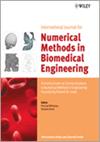Analysis of rubber‐like materials using meshless local Petrov–Galerkin (MLPG) method
引用次数: 6
Abstract
Large deformations of rubber-like materials are analyzed by the meshless local Petrov–Galerkin (MLPG) method. The method does not require shadow elements or a background mesh and therefore avoids mesh distortion difficulties in large deformation problems. Basis functions for approximating the trial solution and test functions are generated by the moving least-squares (MLS) method. A local mixed total Lagrangian weak formulation of non-linear elastic problems is presented. The deformation gradient is split into deviatoric and dilatational parts. The strain energy density is expressed as the sum of two functions: one is a function of deviatoric strains and the other is a function of dilatational strains. The incompressibility or near incompressibility constraint is accounted for by introducing the pressure field and penalizing the part of the strain energy density depending upon the dilatational strains. Unlike in the mixed finite element formulation, in the MLPG method there is no need for different sets of basis functions for displacement and pressure fields. Results computed with the MLPG method for a few sample problems are found to compare very well with the corresponding analytical solutions. Copyright © 2007 John Wiley & Sons, Ltd.用无网格局部Petrov-Galerkin (MLPG)方法分析类橡胶材料
采用无网格局部Petrov-Galerkin (MLPG)方法分析了类橡胶材料的大变形。该方法不需要阴影元素或背景网格,因此避免了在大变形问题中网格失真的困难。利用移动最小二乘法生成近似试验解和测试函数的基函数。给出了非线性弹性问题的局部混合全拉格朗日弱公式。变形梯度分为偏变形和膨胀变形两部分。应变能密度表示为两个函数的和:一个是偏应变的函数,另一个是膨胀应变的函数。不可压缩性或近不可压缩性约束是通过引入压力场和惩罚依赖于膨胀应变的应变能密度部分来解释的。与混合有限元公式不同,MLPG方法不需要为位移场和压力场设置不同的基函数集。用MLPG方法计算的结果与相应的解析解非常吻合。版权所有©2007 John Wiley & Sons, Ltd
本文章由计算机程序翻译,如有差异,请以英文原文为准。
求助全文
约1分钟内获得全文
求助全文

 求助内容:
求助内容: 应助结果提醒方式:
应助结果提醒方式:


